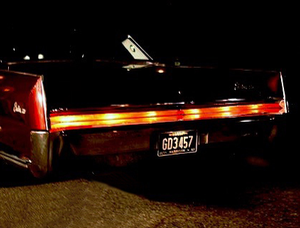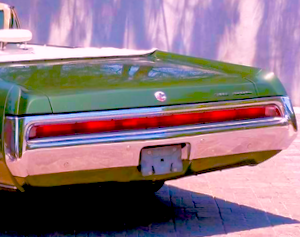James Kraus

1966 Ford Thunderbird
In the 1960s, many automotive designers began toying with the concept of a single tail lamp stretching across the stern like a single red florescent or neon tube. This idea was first expressed at the rear of the 1964 Pontiac Le Mans.
The Le Mans sported a full-width rear grill of horizontal chrome ribs with tail lamps placed behind it at each end, a style Pontiac previously used on Grand Prix models.
This time however, the centre section was backed by metallic red paint to produce (under favorable daytime lighting conditions) the illusion of a single full-width lamp unit.

1965 Buick Skylark
Buick then picked up the single tail lamp baton, employing two different partial executions on their 1965 models. The Electra was given a pair of rather wide lamps separated by a small Le Mans style metallic red-filled trim panel, while the Skylark moved closer to the goal with a broad set of lamps that came very close to meeting at the centre, divided by nothing more than a circular Buick badge.
Meanwhile, to distinguish their new top-line Monaco from the more humble Polara and Custom 880, Dodge added a pair of model-specific tail lamps that were visually connected by a pair of translucent red plastic strips inset into the rear deck lid trim.
For 1966, true unilamp taillights finally emerged; one from each of the Big Three U.S. automakers.

1966 Buick Electra
Buick took the logical next step from the rear styling introduced on the ’65 Electra and Skylark by letting the tail lamps fully converge to produce an uninterrupted, fully-illuminated unilamp for the 1966 Electra 225.

1966 Ford Thunderbird
Not to be outdone, Ford took the animated sequential-indicator tail lamps it debuted on the 1965 Thunderbird and incorporated them into a new unilamp design that also featured a bi-colour centre section able to perform both tail and reversing lamp functions by emitting red or white light as needed.
Obviating the need for the aesthetic intrusion of separate reversing lamps and featuring animated turn indication (now back in vogue), this application was the undisputed king of unilamp design.

1966 Dodge Charger
A few months after the release of the Electra and Thunderbird, Chrysler introduced the new Dodge Charger. Complimenting the à la mode flair of its sleek fastback roofline was a now very much au courant full-width unilamp.
While the Buick and Charger made do with six bulbs powering their unilamps, the Thunderbird used no less than nine, endowing it with a more uniform crimson glow across its entire span. With the brake pedal depressed when reversing after dark (all seventeen filaments energized) its massive rear lamp cluster drew a prodigious 310 watts of electrical power.
The next few years saw a number of cars appear in showrooms with reflective vinyl, red paint or translucent red plastic between the tail lamps to mimic at least the daytime allure of a unilamp in the manner of the ’64 Pontiac Le Mans. These included the AMC Javelin and AMX, Dodge Polara, Ford Zodiac, Holden Monaro GTS and some versions of the Plymouth Barracuda and Ford Torino.
These pretenders of course failed to produce the enticing night time florescent-like radiance of a genuine unilamp.

1970 Chrysler 300
The decade’s last new application of a true fully-illuminated unilamp appeared in the fall of 1969 on the 1970 Chrysler 300, while unilamp designs would continue to be a feature of various Thunderbirds throughout the ‘70s and into the early ‘80s.
Non-functional faux unilamps appeared at the rear of several models from the 1970s through the 1990s. Honda designers were particularly keen, using them on the Civic, Ballade, Legend, Prelude and NSX; while genuine illuminated units were incorporated into the Buick Century and Lincoln Mark VIII. Meanwhile unilamp styling made its frontal debut on Mercurys, the Subaru SVX and Pontiac Grand Prix.
The most notable and oft-imitated example of a faux unilamp appeared on the rear of the Porsche 911 when it was redesigned to accommodate U.S. bumper regulations in the fall of 1973. It remained a styling feature of the 911 for 25 years. After a brief hiatus, it returned on the Carrera 4 in 2002.

2017 Porsche Panamera
Nine years later, the Dodge Charger returned to form with a full-width unilamp, after which Porsche at long last illuminated the centre of the Carrera 4 lamp assembly, and their Panamera now features a bona fide unilamp. The Bugatti Chiron is fitted with a particularly dramatic rendition, and the unilamp has become a key design cue at Lincoln.
All tributes to the Sprit of ‘66.
The Citroen SM never sported a unilamp despite appearances http://p4.storage.canalblog.com/46/50/957843/102493273.jpg. And for all the fuss, maybe it would have looked better with the license plate between the two tail lights and without the bump on the hatch instead.
The SM did have a vaguely faux unilampesque look at the rear that was unique and quite distinctive in that the non-functioning centre section was rendered in amber (except in North American markets) rather than the usual red.
Unfortunately, the full-width effect was lost due to the fact that the three amber sections were seperated by a pair of reversing lamps.
The “TAIL BLAZER” was offered by Citroën for the BX as an Official ACCESSOIRIE and did the same, fitting exactly in the space between the rear light clusters to look continuous. I am currently selling one in the UK where they are now very rare…
https://preview.netcarshow.com/Nissan-Cube-2010-1600-23.jpg Could the latest generation Nissan Cube be construed as having a unilamp?
Since the centre portion is non-functional (unilluminated), the Cube’s rear lamp cluster qualifies only as a faux unilamp. Also, due to the location of the turn indicator and reversing lamps, even if the centre was illuminated, the Cube would fail to project the enticing unbroken broad band of red light that is the hallmark of a genuine unilamp.
The latter issue could be addressed by making the turn indicator and reversing lamps bicolour à la the 1966 Thunderbird, easily accomplished today with LED technology.
Pingback: Four-Links – 2JZs in everything, West Coast Crosley | Hemmings Daily
The larger Buick’s rear styling was so successful that beginning the next year’s Lincolns wore a very similar look. This continued through the ’60s. Not to be confused with the Thunderbird, the similarities between the two brands were not limited to just the taillamps but continued through the styling of the rear fenders and 2-door rooflines which resulted in handsome cars.